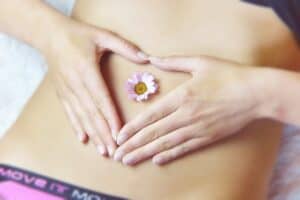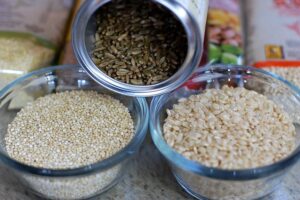There are a number of physiological differences between men and women, the most important difference, from the fitness and dietary side, is the menstrual cycle. This monthly cycle of hormonal variations that women undergo changes their physiology at fundamental levels, but also introduces a complexity that is simply not seen in men.
It is the menstrual cycle that is responsible for the phenomenon that we will talk about in a little more detail today – PMS and how to deal with PMS, but for a start we will briefly explain the menstrual cycle itself.
Characteristics of the menstrual cycle
The menstrual cycle comes from the Latin word for month (a period of time, not a cosmic body) and denotes a cycling period of time (average duration of 28 days) that women go through from puberty to menopause.
Although 28 days is taken as the average cycle duration, the normal time is 24 to 32 days. The meaning of the cycle is the preparation of the female body for the possibility of conception and pregnancy, and all hormonal changes that occur (which we talk about below) are directed towards this goal.
What we need to know is that the cycle itself is divided into two different phases.
The first phase is called the follicular phase – it lasts 14 days (average) and can be divided into early, middle and late follicular phase. It starts with menstruation and ends with ovulation.
The second phase is called the luteal phase. This is the phase that interests us when we talk about PMS. It also lasts an average of 14 days, from ovulation to the start of menstruation.
The late luteal phase of the menstrual cycle is characterized by a drop in the hormones estrogen and progesterone, and it is this event that has a lot of consequences for the female body.
PMS
In women who experience symptoms, the late luteal phase is marked by premenstrual syndrome (PMS). There is a large variability, with some women not experiencing negative symptoms of PMS at all, while in those women who do experience symptoms there is a large variability in the timing of the manifestation of this syndrome.
Studies have shown that PMS occurs on average in 30-40% of the female population, while 5-10% develop a more severe form of the syndrome called PMDD – Premenstrual Dysphoric Disorder.
PMS comes with a number of symptoms:
- Mental: depression, crying, mental tension, mood swings, behavioral disorder, loss of inspiration, social isolation, activity disorder, loss of concentration, loss of self-confidence.
- Physical: fatigue, chest pain, bloating, stool problems (constipation / diarrhea), urination problems (increased / decreased), sweating, acne, joint pain, migraine / headache, incoordination, itching, increased discharge (vagina, sinuses…), dizziness, hunger, weight gain, vomiting, palpitations, indeterminate abdominal pain, sleep disturbance, decreased or increased sexual activity.
PMDD is clinically similar to PMS but with worse symptoms and it makes it difficult for a woman to function in all areas of life.
Hormonal changes
Due to low estrogen levels, women may experience hot flashes (heat waves) which are a typical symptom for the time after menopause. But interestingly, some women feel absolutely no symptoms.
During this period, there is a strong instability of blood glucose, which can cause hypoglycemia, which in turn negatively affects energy levels, mood and hunger. This is the period when women feel the greatest craving for energy-rich foods high in fat and sugar, and this is a huge problem when trying to lose weight.
The craving for highly palatable foods in this period has not yet been fully explained, but serotonin and dopamine levels in the brain appear to have a significant impact, i.e., a drop in their levels leads to stronger cravings.
Water retention is another symptom of this period. Progesterone binds to aldosterone receptors and thus reduces its activity. After a drop in progesterone levels, it moves away from the receptor and aldosterone can bind normally. This reduces its effect on expelling water, and during this period most water is retained in the body, and the effect itself is the worst if a person ingests high levels of salt or does not ingest enough potassium through the diet.
Although not often talked about, sleep quality is also significantly reduced during this period of the cycle. Melatonin, which is involved in the normal regulation of sleep, is particularly sensitive to light exposure during this period, which can reduce the possibility of falling asleep.
There are a number of different methods that try to ensure better sleep quality:
- Avoid light late at night – especially blue light
- The room must be dark and comfortable temperature
- Use sleeping masks and put earplugs to reduce noise
Use dietary supplements – more about this in one of our next articles
How to deal with PMS?
Prevention / treatment of PMS is of great interest (for obvious reasons) and over the years a number of protocols and products have been developed with varying degrees of success. From protocols that we have scientific evidence of leading to improvements to as many or more products or protocols that have strong marketing behind them, but a positive effect equal to zero.
Regular physical activity has been shown to reduce the classic symptoms of PMS, but in some severe cases of PMS, conducting physical activity can be significantly more difficult.
Relaxation techniques (stress reduction) have been shown to reduce the symptoms of PMS. It is important to find techniques that suit the person individually. It can be a hot bath for one, while for another it can be targeted meditation.
Numerous dietary patterns, nutritional strategies, and dietary supplements have been proposed to reduce symptoms and they can have more or less positive effects.
Emphasis should be placed on the intake of plant foods – whole grains, vegetables, fruits and lean sources of protein, low fat dairy products and soy.
Deal with PMS – Recommended dietary changes
Large spikes in insulin levels are the cause of food cravings and mood swings, one of the worst symptoms of PMS, especially because they have a direct impact on energy balance and body composition.
In this regard, the best option is to watch out for carbohydrate sources. Complex carbohydrates are low glycemic index and rich in fiber, which means that they gradually release glucose into the bloodstream, are a continuous source of energy and do not lead to insulin spikes.
What are those foods?
Whole foods impose themselves as arguably the “best” source of carbohydrates, and these include:
Whole grains – oats, quinoa, barley, brown rice, bulgur, rye, spelled …
Legumes – lentils, beans, peas, chickpeas …
Vegetables – carrots, sweet potatoes, pumpkin, asparagus, potatoes …
Fruits – apple, banana, citrus, peach, berries …
2. Focus on individual nutrients
Calcium, magnesium, fish oil and phytoestrogens are nutrients that can all have certain benefits in PMS.
Calcium – There are indications that calcium intake at 1200 mg per day may lead to a reduction in PMS symptoms.
Magnesium and zinc – Changes in estrogen and progesterone levels during the late luteal phase of the cycle lead to changes in serotonin and dopamine levels, leading to increased cravings, appetite in general, and mood swings. Magnesium and zinc improve serotonin signaling thereby, at least in part, ameliorating these symptoms.
In the midst of magnesium supplementation, food cravings in particular decrease, but magnesium intake can also reduce the intensity of other PMS symptoms – menstrual migraines and abdominal cramps. The recommended doses are 25 mg of zinc and 400 mg of magnesium per day.
Omega 3 fatty acids – They have many positive effects, mostly because people don’t get enough of them on a daily basis. Intake of sufficient amounts of EPA and DHA has been shown to reduce the symptoms of PMS and we must emphasize that it is wiser to ingest them through food given the much better absorption. The required daily dose is 1.5-3 grams of a combination of EPA and DHA, which is extremely difficult to achieve without the intake of blue fish. The problem is that even the best dietary supplements only have about 1g of their combination, while most have much, much smaller doses.
Furthermore, 2 grams of krill oil has been shown to be better at reducing PMS symptoms than 2 grams of fish oil. However, the point is that krill oil is more concentrated on EPA and DHA making their dose in the oil simply higher. Due to the higher cost and lack of evidence that when the concentration of EPA and DHA has the same higher effect of krill oil, they are not considered a better solution in PMS.
Phytoestrogens – Research is quite divided when it comes to phytoestrogens. One reason is that people differ in their ability to metabolize phytoestrogens – some people metabolize phytoestrogens well, while some hardly metabolize them at all, with those who metabolize phytoestrogens well feeling benefits not seen in others. One of such positive effects is the reduction of PMS symptoms, which is why women could benefit from consuming soy in the late luteal phase of the menstrual cycle.
Additionally, increased potassium intake with control, not necessarily lower sodium intake, will certainly help with water retention problems. It is best to optimize this through diet, but if this is contraindicated or you are not sure how to put it into practice, dietary supplements can be helpful.
We hope this article will help you to deal with PMS symptoms in a better way.
RELATED POSTS
How To Increase Fertility After 35
In addition to health and genetic problems, fertility after 35 in both men and women is significantly affected by a number of environmental factors. Therefore,…
5 Benefits Of Practicing Yoga In Difficult Times
In the last few years, yoga has become more popular. Especially in the last year when pandemics started and this is completely understandable because yoga…
Simple Ways to Speed up Your Metabolism
Do you wonder why the scale doesn’t move even if you are doing everything right? You are exercising and following a diet, but there’s no…
Why is Dietary Fiber Important
Discover the major benefits of dietary fiber and why it is important for your health. Dietary fiber is important for the health of your gastrointestinal…




